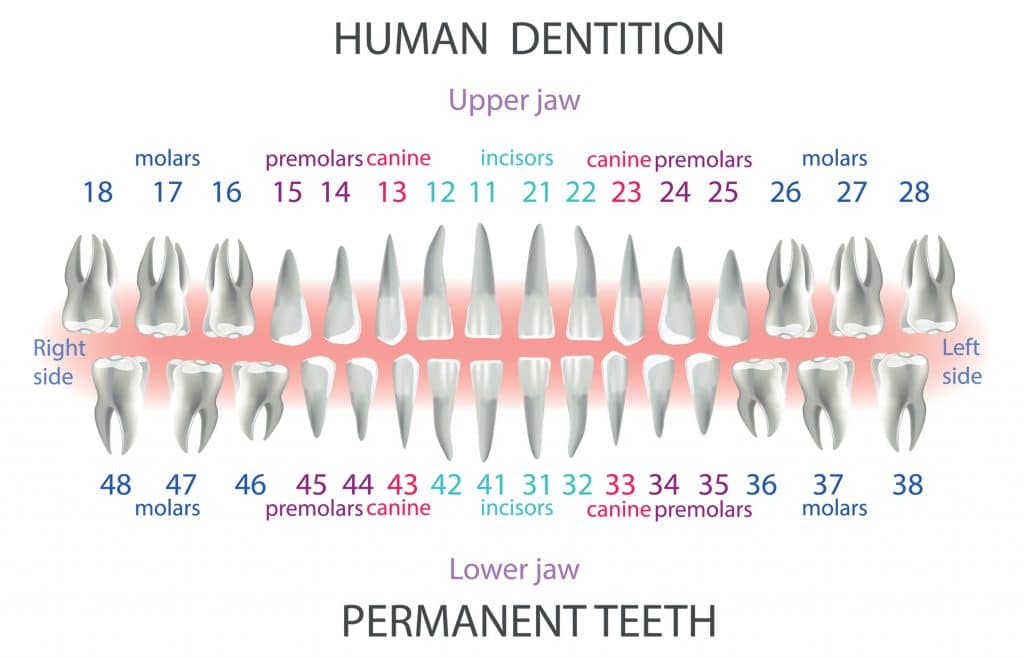How Are Teeth Numbered?
In order to understand some of the treatments that your dentist may provide, you may want to know about the dental naming system. Teeth numbers are a standard way by which dentists around the world can communicate in a way that each other will understand regarding teeth.
Sometimes visiting your dental orthodontic office can often feel like visiting a different country. There are lots of unusual things around you in a new environment, and sometimes people speak in a coded language that seems very difficult to understand. What is this code language?
Understanding the Tooth Numbering Chart

That is the tooth identification system. Many people do not realize that the teeth numbering chart are a simple scientific system. These tooth numbers can usually be seen on a dental tooth number chart, also sometimes called a teeth numbers chart, which is usually posted somewhere in the office if not in the very room you are in.
This tooth chart numbers will oftentimes include things like teeth name, and the teeth by number, and will show you what these dental teeth numbers mean. A teeth chart numbers are an important part of any dental office as helping patients know-how are teeth chart numbered, what are the human teeth names, and what the dental teeth number chart means, can all help with tooth identification especially if there are any aches or issues with a particular tooth number. A tooth numbering chart system is routinely used in most dental practices for naming teeth, recording dental data, and communicating among dental professionals (Havale R et al., 2015).
Knowing how to number teeth and what the names of teeth are is an important aspect of being able to identify which teeth may be causing the problems. There are various systems for the primary and permanent teeth (Havale R et al., 2015).
The Universal numbering system is the one that has been adopted by the American Dental Association and it is also the one most commonly used by dentists worldwide. Then there is the Palmer notation system that is typically used by oral surgeons, orthodontists, and pedodontists. Last we have the FDI system which is used in all branches of dentistry around the world.
The fact of the matter is that most of it have been standardized. Although the primary or milk teeth erupt first, most dental nomenclature systems are focused on permanent teeth and are modified for primary teeth (Havale R et al., 2015).

What is the Universal Tooth Numbering System?
But this may lead individuals to ask the next likely question, what are the tooth numbers? tooth chart numbered in Adult based on their position in the mouth. Because the vast majority of people happen to have similar tooth structures and a similar number of teeth in their mouth, it makes it easy to be able to create a universal map of the mouth using a tooth numbering system so dentists can keep an eye on problem areas.
Your teeth are basically all given names that number 1 through 32 and are most often done in a clockwise counting fashion. In this scale, that would mean that numbers one, number sixteen, seventeen, and thirty-two would be labeled as your wisdom teeth numbers if you still have them and they have not been taken out. 14 and 15 for instance would be your upper left molars. Knowing the different numbers of teeth can be helpful in case you’re having a particular issue in your mouth and would like your dental office to know where you’re having pain or discomfort.
Human teeth names
However, in addition to dental tooth numbers, they also likely have names of teeth associated with them as well. We’ve already mentioned wisdom teeth –these are the teeth that come in later in life usually after adult teeth are well in and in many cases may not come incorrectly at all. This is why getting wisdom teeth removed is a common dental procedure. After the wisdom teeth, you have your molars. Molars, along with your wisdom teeth if you have them, are the primary chewers and are located in the back of your mouth. It is because of this that many individuals may suffer from problems back there since they are more difficult to brush and floss correctly and that means that you should try to pay extra special attention to them.
Teeth numbers and names
After molars come to your premolars. These are smaller than the back teeth but still form an important function in helping you to chew and crush food as the first stage of digestion. Next, come to your canine teeth, and for the vast majority of people, these will be their longest teeth. These are the ones that most people think of when they think of vampires. Although in the case of humans, they are simply used to help you tear food and maintain a firm bite grip.
The next teeth are the incisors. These are the ones right in front. These incisors are thick at the top and thin at the bottom and are sharp. They are ideal for slicing food into bite-sized chunks before you move them to the back of the mouth to be crushed by the molars. All of these teeth work together to help you chew and crush your food before swallowing.
Teeth name
Here’s how your teeth work. For instance, when eating an apple, you will take a bite. Your incisors will slice, and your canines will help pull it off as you pull the apple away from your mouth. Following the slice and tear, you will absent-mindedly begin moving the bite back to your premolars which will begin crushing and grinding the apple before it ends up at the molars themselves. The molars will do most of the heavy lifting and continue pulverizing and crushing your bite until it is safe for you to swallow. This entire process is largely absent-minded and although we certainly can control where things go in our mouth if we are interested, the fact is your mouth is a precisely tuned instrument ideal for helping to crush food and make it safe for you to swallow and digest.
Tooth identification
With the knowledge of how dental identification tooth numbers work and what the teeth numbers and names are, next time you go to your dental office, take a look at a wall and see if you happen to see that tooth numbers chart there. That way when you hear your dentist or orthodontist calling out the numbers of your teeth, you’ll know exactly which ones they mean.
Reference:
Havale, R., Sheetal, B. S., Patil, R., Hemant Kumar, R., Anegundi, R. T., & Inushekar, K. R. (2015). Dental notation for primary teeth: a review and suggestion of a novel system. European journal of pediatric dentistry, 16(2), 163–166.
Contact us:
IVANOV Orthodontics, 12866 Biscayne Blvd, North Miami, FL 33181
https://www.google.com/maps?cid=154326063970645489
Call us at (786) 540-1919 to schedule a free orthodontic exam.
Is There a Limit On the Age To Get Teeth Braces?

